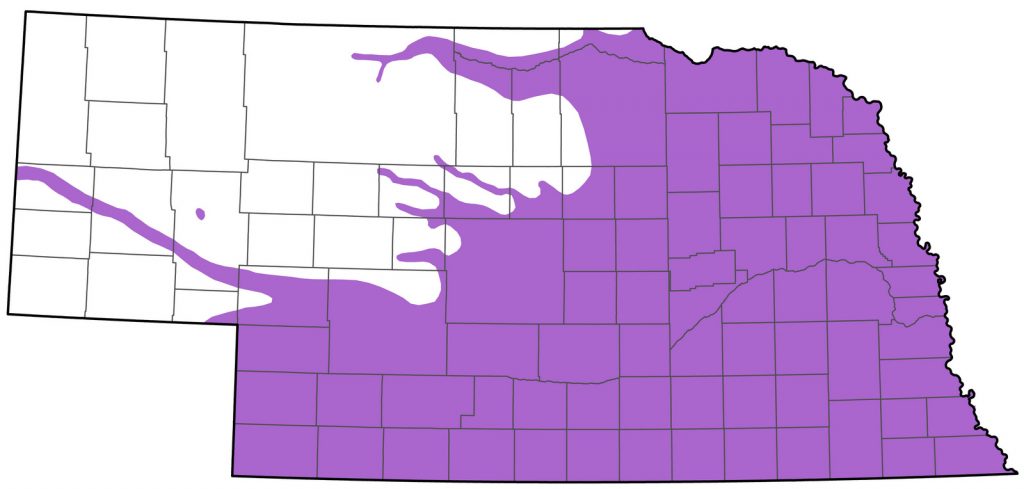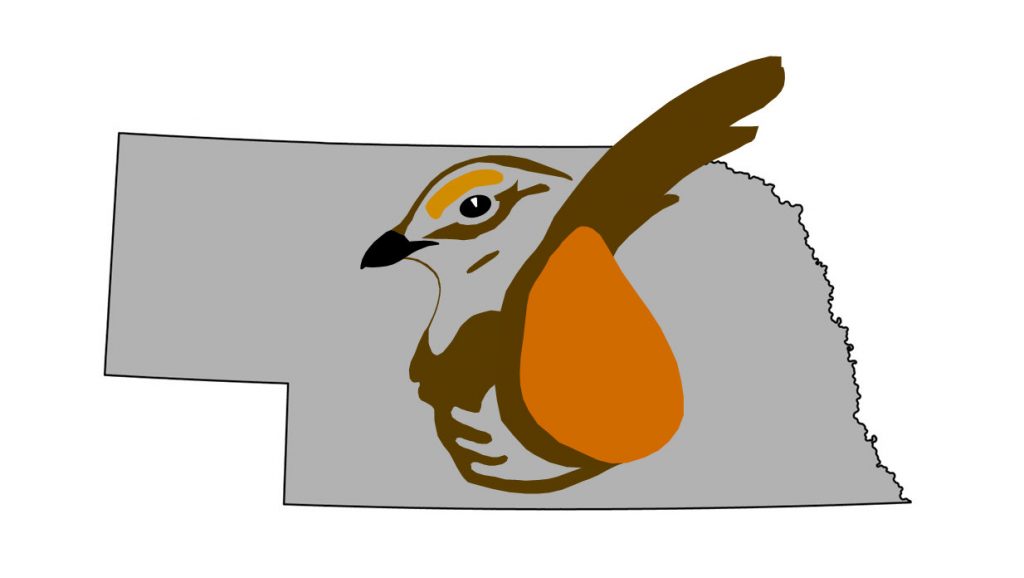Colinus virginianus taylori
Status: Fairly common regular resident east and most of central; rare elsewhere.

Documentation: Specimen: UNSM ZM6093, 19 Jun 1902 Keya Paha Co.
Taxonomy: AviList (2025) recognized 20 subspecies; subspecies mexicanus and marilandicus recognized by Brennan et al (2020) were included within virginianus by AviList (2025).
The range of mexicanus (=viginianus) was described by Brennan et al (2020) as “Resident in extreme S Canada (SE Ontario) and C USA from E South Dakota E to W New York, S to E Texas, Alabama and W South Carolina.”, and of taylori as “Resident in C USA from C South Dakota S to N Texas and E to W Missouri and NW Arkansas.” The range given in Brennan et al (2020) for taylori thus resembles that suggested by (Williford et al 2014), who proposed that west of the Mississippi River all Northern Bobwhites were referrable to taylori, but noted considerable gene flow and haplotype diversity.
Based on the above, we recognize taylori as occurring in Nebraska; there is no evidence for occurrence of mexicanus (=viginianus).
An occasional rufous (carotenistic) morph occurs (Pyle 2008); they are available also from breeders and males resemble a Masked Bobwhite (Scott Taylor, NGPC, personal communication). Sightings of single birds occurred in Scotts Bluff Co 23 Oct 2003 and Thayer Co in summer 2003. Occasional releases of various forms of bobwhite are made as well for hunting purposes.
Resident: The range of this species in Nebraska has apparently changed little in more than a century, as Bruner et al (1904) noted that, while it was formerly limited to the east, it was now distributed “practically over the entire state, especially along river and creek valleys and about farms where natural shelter occurs.”
Nebraska is at the northwest edge of the range of this species; abundance and extent of range fluctuate in response to environmental variables. Thus, individuals are routinely observed outside of mapped range during population peaks, but the species may also be absent from portions of the mapped range during population lows. Generally, densities are highest in the southeast (Lusk 2017), but the species is found throughout the Platte and Republican River Valleys, although rare in the North Platte River Valley, and uncommon in the central Niobrara River Valley (Brogie and Mossman 1983) where the range extends west to Cherry Co in the Snake Creek area and to Valentine NWR. Rosche (1994) considered it “sporadic” in the Keith Co area, varying from nearly absent in some years to fairly common in others.
In the Panhandle, occurrence is spotty. In northwest Nebraska, its occurrence is irregular and “highly variable” and dependent on severity of winter weather (Rosche 1982, Johnsgard 1997). One was heard at Peterson WMA, Sioux Co 9 Aug 2018, and 12 were on the Harrison CBC, Sioux Co 30 Dec 2007. In Dawes Co between 2003 and 2008 there were four reports, including eight on the Crawford CBC 20 Dec 2005. In 2004, it was considered resident at Smith Lake SRA, Sheridan Co, but reports are lacking there since then; five were reported near Gordon, Sheridan Co 18 Feb 2019. In 2019, a veteran observer living near the Wildcat Hills in Scotts Bluff Co reported: “In almost 50 years of living in the middle of a native grass pasture, it is the first [bobwhite] I’ve seen or heard.” At least one was seen or heard there daily 18-27 Jul, possibly part of a covey of 6-8 that had been less than a mile away for a few months according to a neighbor (Alice Kenitz, personal communication). One or two were in the same yard 5-13 Jun 2020 and one was at nearby Buffalo Creek WMA 23 Aug 2023. Two flushed in southern Morrill Co 17 Jun 2007 were the first seen there by a local farmer in 40 years. Between 1996 and 2016 a few reports from Crescent Lake NWR, Garden Co included a high count of 12 on 31 Oct 1996. One was heard at Oliver Reservoir, Kimball Co 6 Sep 2018. In Cheyenne Co, one was along Lodgepole Creek 10 Aug 2014 and one was calling at Lodgepole WTP 4 May 2025. One was at Chappell Lake, Deuel Co 8 May 2023.
In the west central Sandhills there are occasional recent reports west of the Loup drainage, which extends to Thomas (Middle Loup and Dismal rivers) and Logan (South Loup River) Cos. Singles were reported in Grant Co 4 Sep 2021 and 18 Jun 2025, and in Hooker Co at Mullen 10 Jul 2020 and the Dismal River crossing 6 May 2025. There are these reports for McPherson Co: 9 Jun 2024 at both Diamond Bar Road and along CR60, 13 Jun 2014 and 13 Jun 2024 along the Arthur/McPherson county line, 27 Jun 2025 (2) at Ringgold Road, 17 Jul 2015 at Hiway 97, and 28 Jul 2010 at Moore Ranch.
CBC data indicate highest populations in the east and south (0.568 and 0.565 birds per party hour), declining to the north (0.343) and west (0.172). An excellent CBC tally at the northern edge of the range was the 102 on the Calamus-Loup CBC 30 Dec 2015; in the south, a count high 117 were found on the Harlan Co CBC 15 Dec 2016.
Flocking occurs by late Aug; 30 were counted at Johnson WPA, Phelps Co 20 Aug 2000, and coveys of up to 40 birds are found in fall and winter. Near Benedict, York Co, the 30 on 9 Jul 2025 indicated “a good hatch in native prairie”.
- Breeding Phenology:
Eggs: 1 May- 24 Aug (Mollhoff 2022).
Dependent young: 23 Jun-17 Aug.
A nest with eggs was found in Boone Co as late as mid-Sep (Mollhoff 2001); such records may be of double broods or replacement clutches (Mollhoff 2022). A pre-fledged chick was in Dodge Co 27 Oct 2015.
Abbreviations
AOU: American Ornithologists’ Union
CBC: Christmas Bird Count
NGPC: Nebraska Game and Parks Commission
NWR: National Wildlife Refuge
SRA: State Recreation Area
UNSM: University of Nebraska State Museum
WMA: Wildlife Management Area (State)
WPA: Waterfowl Production Area (Federal)
Literature Cited
American Ornithologists’ Union [AOU]. 1957. The AOU Check-list of North American birds, 5th ed. Port City Press, Baltimore, Maryland, USA.
AviList Core Team, 2025. AviList: The Global Avian Checklist, v2025. https://doi.org/10.2173/avilist.v2025.
Brennan, L.A., F. Hernandez, and D. Williford. 2020. Northern Bobwhite (Colinus virginianus), version 1.0. In Birds of the World (A. F. Poole, Editor). Cornell Lab of Ornithology, Ithaca, NY, USA. https://doi.org/10.2173/bow.norbob.01.
Brogie, M.A., and M.J. Mossman. 1983. Spring and summer birds of the Niobrara Valley Preserve, Nebraska: An annotated checklist. NBR 51: 44-51.
Bruner, L., R.H. Wolcott, and M.H. Swenk. 1904. A preliminary review of the birds of Nebraska, with synopses. Klopp and Bartlett, Omaha, Nebraska, USA.
Johnsgard, P.A. 1997. The birds of Nebraska and adjacent plains states. Occasional Papers No. 6, Nebraska Ornithologists’ Union. Lincoln, Nebraska, USA.
Lusk, J. 2017. Northern Bobwhite Whistle Count. W-15-R-74 Federal Aid in Wildlife Restoration Project Report. Nebraska Game and Parks Commission, Lincoln, Nebraska, USA.
Mollhoff, W.J. 2001. The Nebraska Breeding Bird Atlas 1984-1989. Nebraska Ornithologists’ Union Occasional Papers No. 7. Nebraska Game and Parks Commission, Lincoln, Nebraska, USA.
Mollhoff, W.J. 2022. Nest records of Nebraska birds. Nebraska Ornithologists’ Union Occasional Paper Number 9.
Pyle, P. 2008. Identification Guide to North American Birds. Part II, Anatidae to Alcidae. Slate Creek Press, Bolinas, California, USA.
Rosche, R.C. 1982. Birds of northwestern Nebraska and southwestern South Dakota, an annotated checklist. Cottonwood Press, Crawford, Nebraska, USA.
Rosche, R.C. 1994. Birds of the Lake McConaughy area and the North Platte River valley, Nebraska. Published by the author, Chadron, Nebraska, USA.
Williford, D., R.W. Deyoung, R.L. Honeycutt, L.A. Brennan, F. Hernández, E.M. Wehland, J.P. Sands, S.J. Demaso, K.S. Miller, and R.M. Perez. 2014. Contemporary genetic structure of the northern bobwhite west of the Mississippi River. Journal of Wildlife Management 78: 914-929.
Recommended Citation
Silcock, W.R., and J.G. Jorgensen. 2025. Northern Bobwhite (Colinus virginianus). In Birds of Nebraska — Online. www.BirdsofNebraska.org
Birds of Nebraska – Online
Updated 8 Sep 2025
